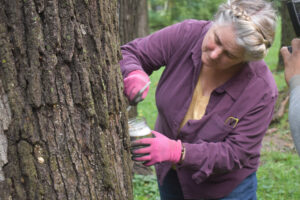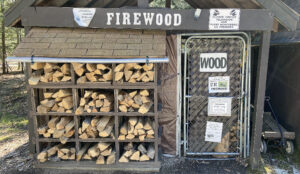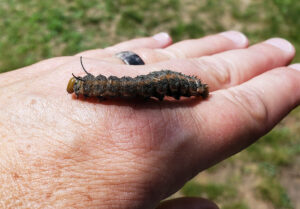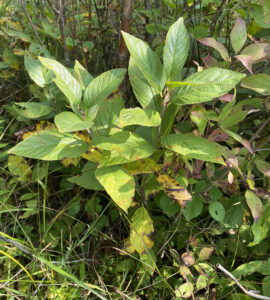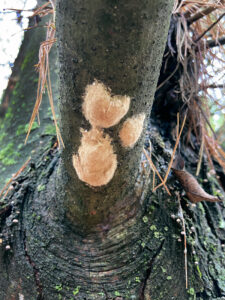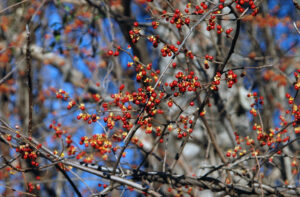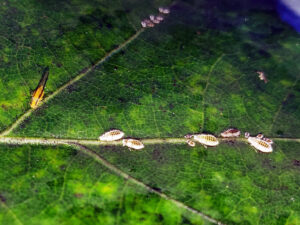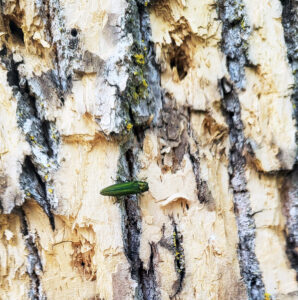By Erika Segerson-Mueller, DNR Invasive Plant Program Specialist, Oshkosh Service Center;
Erika.Segersonmueller@wisconsin.gov or 715-492-0391
As we move into cooler temperatures, many plants and trees are changing in leaf color and even beginning to drop their leaves. The Wisconsin Department of Natural Resources (DNR) reminds the public that fall is not only a great time to enjoy the changing hues in the woods, but it also presents a good opportunity to spot the invasive plants persisting among them.
As you walk through your woods this month, look for leaves that stay green into late fall, even after all other trees have lost their leaves. These are likely signs of an invasive plant species.
Invasive plants can hold onto their leaves much longer than native plants, taking advantage of late fall sunshine and ensuring they continue to grow and gain ground in the forest after many other plants have already died out or gone dormant for the winter.
Late autumn and even early winter are great times to identify and treat invasive plants. They are easy to see in a sea of downed leaves and dead plants. The absence of living native plants means that treating invasives with chemical herbicides will cause much less collateral damage.
Fall treatment is ideal for woody invasives, as trees and shrubs are busy directing resources to their roots to store them for overwintering, so the natural flow carries the herbicide along to the roots. Spring treatments are often ineffective because the opposite is true: plants are continually pushing resources up and out toward new buds.
When a control method like cut-and-swipe (a common treatment for buckthorn that involves snipping off stems and using a dabber to apply herbicide directly to the cut) is used in spring, it is often ineffective as the herbicide is immediately pushed out of the plant. In fall and winter, the flow of resources changes, making treatment much more effective.
Common invasive plants that can be treated in fall include garlic mustard, non-native honeysuckles and common and glossy buckthorns. Here are some basic identification characteristics and methods of treatment:
Garlic Mustard
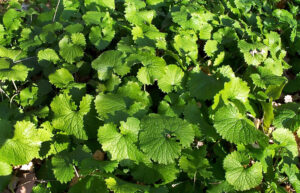
Rosettes on a garlic mustard plant. / Photo Credit: Wisconsin DNR
Though not a woody plant, the basal rosettes (a cluster of leaves at ground level) remain green through the fall and winter and are easy to spot. Garlic mustard looks somewhat like wild ginger or violets due to its kidney-bean shaped leaves. To check, crush a leaf – the leaves of garlic mustard should have a garlic smell when crushed.
If only a few plants are present, they can be hand-pulled and should be destroyed by burning or sending them to a landfill in bags clearly labeled as “Invasive Plants – Approved by Wisconsin DNR for Landfill.” For larger infestations, plants may be cut or torched, or herbicide may be used as recommended in the Control Method section of the Garlic Mustard Fact Sheet.
Non-Native Honeysuckles
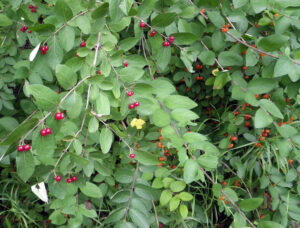
Photo of a honeysuckle plant. / Photo Credit: Wisconsin DNR
Non-native honeysuckles can hold their leaves well into winter. They often have a thick canopy of leaves that shades out native plants. While other plants are bare and the honeysuckle still has that thick canopy, it’s a great time to attack and treat it.
There are several types of invasive honeysuckles in Wisconsin. Learn more about each variety as well as control methods on the Management of Bush Honeysuckles fact sheet from the University of Wisconsin-Extension.
Common And Glossy Buckthorn
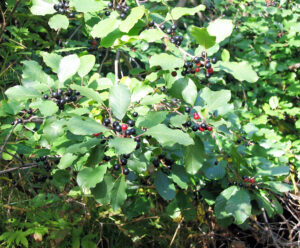
A glossy buckthorn shrub covered in berries. Control berry-producing plants first to prevent further spreading. / Photo Credit: Wisconsin DNR.
A common sight in Wisconsin forests, common and glossy buckthorn is also best treated in late fall and early winter. Buckthorn is a multi-stemmed large shrub or small tree that can form an impenetrable understory layer, displacing native vegetation.
Small buckthorn seedlings can be removed by hand. Larger plants should be cut or girdled at the base. Buckthorn can easily re-sprout from cut stumps, so herbicide treatments are often best. Find more information on control methods on the Buckthorns Management Fact sheet.
After treating any invasive plants in the fall, make sure to follow up in spring to check for new growth and seedlings. Controlling invasive plant species almost always requires multiple treatments and monitoring over several seasons.
